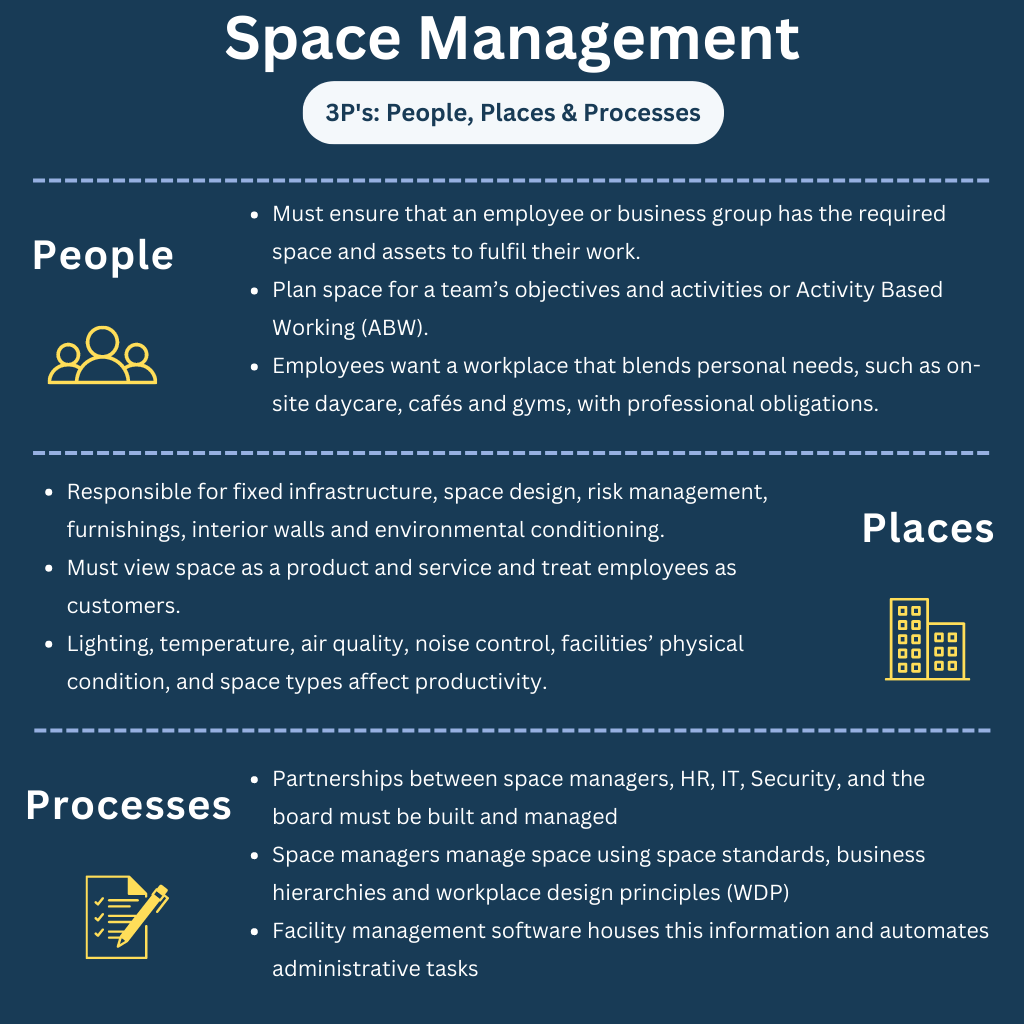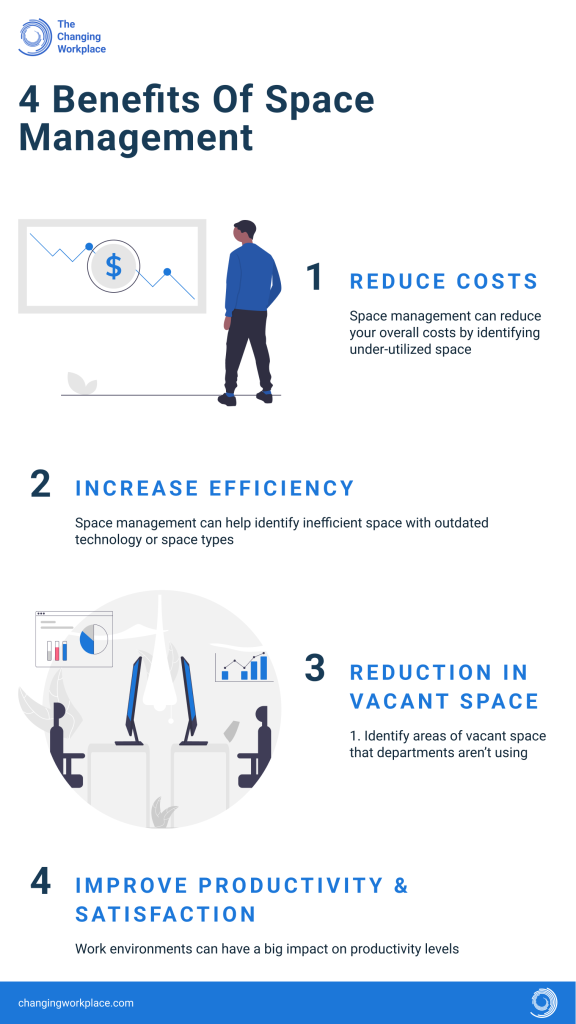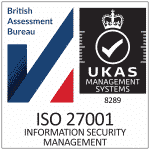Intro
It’s always challenging to balance your organization’s needs with your financial realities. But, first, you must figure out what you need, where and how you can get it, and how much it will cost.
If you focus on improving the use of your real estate portfolio, then you’re likely to experience significant business benefits, including improved efficiency, productivity and profit.
In addition, a well-managed facility leads to better strategic decisions about when and where alternative space is required before the current environment becomes inefficient. Without which, it may lead to poor service delivery and unhappy employees or customers – not to mention unplanned capital expenditure (CapEx).
Clearly, strategic space management is important for any business. That’s why we’ve put together a guide that takes you through what space management is, and how to do it!
What is Space Management?
Space management is managing a company’s physical space and its employees. So, space management ranges from managing building headcounts to implementing new working methods.
It comes under Facility Management, which aims to operate, maintain and improve facilities to support core business operations.
Space management teams have one fundamental goal:
To manage efficient workplaces that support user needs and well-being in line with business objectives.
Effective space management requires focusing on the 3 P’s –” People”,” Places”, and” Process”.
People
Failing to plan for employee well-being affects the delivery of core business objectives. From higher job turnover, lower productivity, greater disengagement and absenteeism.
Places
An organization’s second-highest cost is its space (places). So, a space manager’s primary role is to optimize new and existing space that delivers value to its users and the organization.
Processes
he final element is” processes”, which concerns methods that CRES managers use to manage their Real-estate. When defining space types, organizations have a range of available space standards – MSCI, BOMA, and RICS. Also, organizations can create their standards.
Furthermore, organizations generally have Workplace Design Principles (WDP), which reflect an organization’s Corporate Identity as well as define which departments need specific spaces.

The Benefits Of Space Management
Reduce Costs
Office space management can reduce your costs by reducing the amount of space you have. You can do this by removing unnecessary or unused areas or sharing space with other companies.
Reduction In Vacant Space
One of the most significant benefits of space management is reducing the amount of vacant space. Effective space management involves using data to track space allocation to determine exactly how much money you are wasting on underperforming space.
Improved Staff Productivity & Satisfaction
Space management can help increase your employees’ productivity and improve their performance. For example, lighting, temperature, air quality, noise control, facilities’ physical condition, and the size or configuration of space types affect productivty.
An improved office design will increase staff productivity by making it easier for employees to focus on tasks and avoid distractions. This will also boost morale and motivation, resulting in further productivity gains and cost savings.
Furthermore, when you have a layout that matches your business’s current needs and plans, you can make better decisions about where to divide resources.
Drive Innovation
When you have the right space for your team members and their needs (activity-based working, ABW), it’s easier for them to collaborate and share ideas. Meaning they’re more likely to develop new ways of doing things to help your business stay competitive in the long term.
Driving innovation is a feature of agile working. Correct implementation of agile working focuses on changing the traditional company culture of valuing time.
Instead, new ways of working emphasise completing goals. Focusing on goal completion means businesses can create teams based on their skills and knowledge to complete the task. Evidence suggests that teams of differing skills and backgrounds are better problem-solvers and decision-makers.
Innovation doesn’t mean you have to adopt the latest working trend; for example, hot-desking and hybrid teams may not apply to your business. But, what it does mean is don’t be afraid to change and adapt to the future of work.
The Benefits Of Facilities Management Are Measurable
Facilities management is a tangible and measurable service. You can gauge the performance of your facilities management provider, your facilities management team, your space management tools and processes, and your physical space’s performance!
You can even measure the efficiency of a maintenance request submitted by an employee to have his desk cleaned or a light bulb replaced. This data helps you determine how well your business is using the space and whether there are areas that need improvement.
Energy Efficiency
An undervalued benefit of space management is reducing energy costs. Space management increases the efficient use of space, reducing the power needed to run your facility.
Furthermore, space management helps reduce your carbon footprint by lowering underutilized and vacant space — which is excellent for the Earth!

Space Management Tools
Space Planning Software
Your first priority should be implementing a space management system. Space management solutions give you complete visibility over your real estate portfolio with insights into workspace usage and space costs. These tools, often referred to as CAFM tools, allow you to track space usage, charge departments for usage and create office layout changes
Meeting Room & Desk Booking
The issue many organizations are facing now is assigning employees to fixed workstations is too restrictive and doesn’t support the hybrid workplace model. This is where room booking software helps. Employees are able to reserve space ahead of time or on the go. They can look for conference rooms and hotel desks that match their criteria. Room reservations software also helps organisations measure how their hot desks are performing!
Move Management Software
Moves and changes software might not be as relevant anymore as fewer employees sit in fixed locations. But, if you are a large organization implementing wholesale changes across your portfolio, you need a moves and changes system to help! A move management solution allows you to centralize your entire moves and changes workflow, ensuring everyone has visibility, approvals go to the right people, and track costs as you go.
Smart Building Sensors & Building Entry Systems
Hybrid workplaces are fantastic for employee satisfaction. Employees can work where they want when they want. For organisations, but hybrid working provides a headache for tracking space usage! The answer, Sensors and building entry systems. These systems can provide real-time data on actual space usage, which inform your strategic space planning.
Why You Need A Space Management Strategy
If you want to receive the benefits listed above, you need to have a clear strategy and vision for how you will manage your space.
Like it or not, an organization will have vacant space regardless of what they do. But, space management strategies focus on matching physical space with employee demand or increasing space utilization of existing space.
Doing so helps to reduce the vacancy rate, which, in turn, reduces the costs associated with vacant desks.
Furthermore, proper strategic space planning lets you predict future space needs by looking at the trends of how much space a business occupies.
In short, effective space management strategies will tell you what spaces your employees need and how many. This optimizes your space whilst encouraging employees to do their best work.
How To Create A Space Management Strategy
Current Space Usage - Site Study
You need to understand your space inventory and who is using it. The reality is that employees are not at their workstations up to 60% of the time!
So, gaining real-time data on how employees use the office will help your business achieve its goals.
Tracking space and resource usage provides you with a baseline which allows you to benchmark the success of plans you put in place.
How Do You Collect Space Utilization Data?
Smart building sensors, desk booking apps and badge swipe data are perfect sources of utilization data.
These data sources will give you information like room usage, which departments use what space, for how long, how often etc. This data will show you whether your business rules are correct.
For example, are employees using space properly? Are you providing too much or too little of particular space types?
What If You Have No Sensors Or Booking Systems?
Space surveys come into play to determine whether the space is used for its intended purpose. By conducting manual surveys of your office, you can directly observe how the space is utilized. While sensors and bookings can inform you about which areas are used and for how long, they cannot provide insights into the actual usage of the space.
For example, employees could use meeting rooms as lunch areas. But, sensor data would show this meeting room as occupied. See how this could be misinterpreted?
Survey Your Employee's
Gaining actionable data on what and space usage is a great. But, it lacks an important aspect. User perspective! Any changes you put in place will have the greatest impact on building users. That’s why you must put their needs at the centre of space management planning!
So, make sure you engage them to find out their thoughts and feelings. Speaking to your employees gives you a good insight into what changes they want. But, there is no point asking employees questions about what spaces they would want in the office if they have no intention of using it! Here are some alternative questions to consider:
What are your flexible working preferences?
What is your motivation to come to the office?
Do you have the right infrastructure to work from home?
Do you feel hybrid working allows you to be more productive?
What sort of work do you do when you come to the office? Individual work, collaboration etc.
Create Space Management Objectives
Once you understand how your space usage and what your employees want, you can begin to create some goals. There needs to be a balancing act between meeting the needs of your employees and aligning with the organisation’s strategic direction.
Another important aspect to consider is how you will measure the success of your strategy. This will involve selecting appropriate KPIs. If your goal is reducing real estate, the indicator would be the number of buildings etc.
Space Management Software
The reason this section isn’t higher on the list is it can be difficult to know which systems you need without first understanding what your problems are!
Once you know the techniques you want to use to manage your space, you can start a gap analysis to see which software solutions you are missing.
Take a look at the tools in the section above if you need inspiration!
Scenario Planning Process
Once you know the objectives, you can begin to speak to business heads and agree on new sharing ratios based on utilization and employee feedback in the previous steps. At this point, it is important to consider how aggressive your strategy is, the value of your teams and your aversion to risk. Let me explain:
If your strategic space management plan involves severe space reductions, you need to consider the value of the space. Not its cost but the revenue of your departments. For example, if you have a trading team bringing in millions in revenue, do you want to risk them not having a desk?
Once you agree on a design point with the business heads, you can create new floor plan layouts, plan your moves, create new space standards etc.
Continual Improvement
Building a workplace that works for you and your employees takes time and many attempts. You’ll need to track how your space is used and assess how your current strategy is performing. We recommend reviewing your workplace strategy as and when business requirements and industry trends change!
Things to consider
Space Management Standards & Processes
More often than not, space management strategies that fail are often due to a lack of alignment between how you want to operate and the standards and processes that are currently in place. If you want to create a flexible working environment, you need to make sure you have the right space types, employee data, building measurement standards and more!
Here are some standards to consider:
Business Hierarchy
Occupancy Standards
Business Rules
Move Management process
Data Standardization
Floor Plan Standardization
Data Feeds
Roles & Responsibilities
For an effective space management strategy, each person needs to understand their role. Create a roles and responsibilities table showing each person’s involvement in the space management strategy and their contact details. Doing so streamlines communication and removes confusion should something go wrong.
For most organizations, space data is centralized and is not down to the individual region or country to manage. Businesses should empower the local CRES teams to be responsible for their data. The local CRES teams are in a much better position to make informed decisions.
Training
Making sure everyone is on the same page is vital. Otherwise, all your hard work and effort defining your space management strategy will be for nothing. After all, your CRES teams will be the ones doing the work!
Ensure the teams implementing the strategy understand what you are trying to achieve. Where necessary, put on training workshops to give employees ample opportunity to learn.






